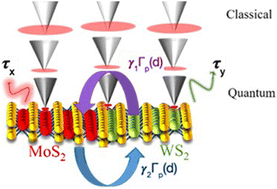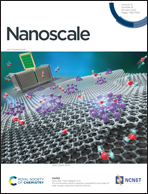Quantum plasmonic two-dimensional WS2–MoS2 heterojunction†
Abstract
Two-dimensional heterostructures have recently gained broad interest due to potential applications in optoelectronic devices. Their reduced dimensionality leads to novel physical effects beyond conventional bulk electronics. However, the optical properties of the 2D lateral heterojunctions have not been completely characterized due to the limited spatial resolution, requiring nano-optical techniques beyond the diffraction limit. Here, we investigate lateral monolayer WS2–MoS2 heterostructures in a plasmonic Au–Au tip–substrate picocavity using subdiffraction limited tip-enhanced photoluminescence (TEPL) spectroscopy with sub-nanometer tip–sample distance control. We observed more than 3 orders of magnitude PL enhancement by placing a plasmonic Au-coated tip at the resonantly excited heterojunction. We developed a theoretical model of the quantum plasmonic 2D heterojunction, where tunneling of hot electrons between the Au tip and MoS2 leads to the quenching of the MoS2 PL, while simultaneously increasing the WS2 PL, in contrast to the non-resonant reverse transfer. Our simulations show good agreement with the experiments, revealing a range of parameters and enhancement factors corresponding to the switching between the classical and quantum regimes. The controllable photoresponse of the 2D heterojunction can be used in novel nanodevices.

- This article is part of the themed collection: Nanoscale quantum technologies


 Please wait while we load your content...
Please wait while we load your content...